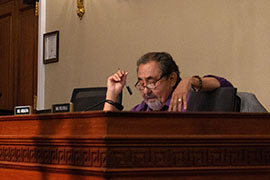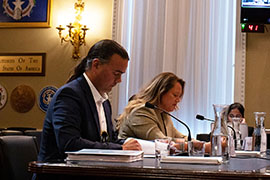- Slug: BC-CNS-Tribal Culture,690
- 3 photos available (thumbnails, captions below)
By Ryan Knappenberger
Cronkite News
WASHINGTON – Tribal leaders urged lawmakers Wednesday to pass a package of bills that would protect cultural and sacred sites by creating a new tribal cultural areas designation and require Native input on any decisions on those lands.
The sponsor of the bills, Rep. Raúl Grijalva, D-Tucson, called them an attempt to “put tribes at the front end, not the back end” of the decisions on cultural and historic sites.
But critics said the bills – including proposals to set aside 377,000 acres in Arizona – are too broad and need to be redrawn “with a scalpel, instead of just a machete.”
The comments came at a House Natural Resources subcommittee hearing on the bills. Grijalva said they were sparked by an ongoing fight over Oak Flat, the site of a proposed copper mine on land sacred to the San Carlos Apache, and proposals for uranium mining near the Grand Canyon.
Many of the supporters were like Gila River Indian Community Gov. Stephen Roe Lewis, who said tribal governments are the most qualified group to help conserve the land because they have been “stewards of these lands since time immemorial.”
“We’ve been doing this for generations, as the remnants of our sacred irrigation systems located in the conservation areas have shown,” Lewis said in testimony via video. “We have solutions that protect the land and address the impacts of climate on our environments.”
The proposals would prohibit the sale of public lands that are, or had been recognized by the government at some point, as tribal land, without the input of tribes. The Advancing Tribal Parity on Public Lands Act would prohibit sale of any land that a tribe has rights to via a treaty with the U.S. and grants tribes the right of first refusal in the sale of any public land they have a historical connection to.
Another bill would codify tribal rights to lands they have connections to by creating the Tribal Cultural Areas System of historic, cultural and sacred sites in Arizona and across the country. Under the bill, tribes would have management authority over such lands, which only Congress could approve or remove.
The final measure, the Great Bend of the Gila Conservation Act, would establish several national conservation areas in Arizona: A 330,000-acre conservation area for the Great Bend of the Gila River, as well as a 47,000-acre Palo Verde National Conservation Area in southern Arizona.
National Congress of American Indians President Fawn Sharp called the bills a step in the right direction.
“Tribal nations would prefer that we own the lands outright, but we recognize that this is a process of repatriating centuries of land alienation,” Sharp said in her testimony.
She said the legislation could help protect important cultural sites from development as the country, particularly states like Arizona, continues to grow.
“There’s a finite amount of land in this country. And within that finite pie, we have to prioritize sacred and special places that have existed for millennia,” Sharp said.
But Stefanie Smallhouse, president of the Arizona Farm Bureau, testified that the conservation areas proposed in Arizona are too broad – she made the “machete” comment – and would negatively impact the work of ranchers in the state.
She worried that federal ownership of the conservation areas would backfire, imposing restrictions on the land that could lead to both economic and ecological damage.
“Livestock grazing is critical for managing and preventing invasive plant species, decreasing hazardous fuel loads to prevent wildfires, supporting wildlife habitats and cultivating rural economies,” Smallhouse said in prepared remarks, pointing to the benefits ranching brings to the environment.
But Grijalva said tribes are too often ignored by policymakers. He pointed to the last-minute amendment crafted by then-Sen. John McCain to a must-pass defense bill in 2014, authorizing a swap of federal land with Resolution Copper in southeast Arizona that could clear the way for a copper mine on Oak Flat.
That proposal is still tied up in legal and regulatory challenges.
“If we would have had legislation that would have given parity to tribes, the tragedy of Oak Flat could have been avoided,” Grijalva said after Wednesday’s hearing.
For more stories from Cronkite News, visit cronkitenews.azpbs.org.
^__=
Web links:
_ Committee hearing: https://naturalresources.house.gov/hearings/npfpl-legislative-hearing_september-14-2022
_ Tribal parity bill: https://www.congress.gov/117/bills/hr8108/BILLS-117hr8108ih.pdf
_ Advancing Tribal Parity fact sheet: https://naturalresources.house.gov/imo/media/doc/ADVANCING%20TRIBAL%20PARITY%20ON%20PUBLIC%20LANDS%20ACT.pdf.pdf
_ Cultural areas bill: https://www.congress.gov/117/bills/hr8109/BILLS-117hr8109ih.pdf
_ Tribal Cultural Areas fact sheet: https://naturalresources.house.gov/imo/media/doc/TRIBAL%20CULTURAL%20AREAS%20SYSTEM%20ACT.pdf
_ Great Bend bill: https://www.congress.gov/117/bills/hr8719/BILLS-117hr8719ih.pdf
_ Great Bend fact sheet: https://naturalresources.house.gov/imo/media/doc/2022.09.07%20Fact%20Sheet_Great%20Bend%20of%20the%20Gila%20Conservation%20Act.pdf
_ Roe Lewis testimony: https://naturalresources.house.gov/imo/media/doc/Lewis,%20Stephen%20Roe%20-%20Testimony%20-%20NPFPL%20Leg%20Hrg%209.14.22.pdf
_ Sharp testimony: https://naturalresources.house.gov/imo/media/doc/UPDATED%20Sharp,%20Fawn%20-%20Testimony%20-%20NPFPL%20Leg%20Hrg%209.14.22.pdf
_ Smallhouse testimony: https://www.azfb.org/ArticleFile/file/ed772a20-d364-4aa9-9015-e9ae60dd0b76/President%20Smallhouse%20NPFPL%20Legislative%20Hearing%209.14.pdf
^__=
The Bears Ears National Monument in southern Utah includes more than 1.3 million acres that a number of tribes in the region say has cultural and historic significance. But it has been at the center of a multiyear tug of war between administrations, a fight that supporters of a group of cultural heritage bills say could have been avoided with greater protections. (File photo by Josh Ewing/Bears Ears Coalition)
Rep. Raul Grijalva, D-Tucson, sponsored the bills to give tribes greater control over historic and sacred sites, saying his goal was to put tribes “at the front end, not the back end” of decisions on public lands. (Photo by Ryan Knappenberger/Cronkite News)
Assistant Interior Secretary Bryan Newland, left, and National Congress of American Indians President Fawn Sharp testify in support of a package of bills that would expand protections for tribal cultural, historic or sacred sites. (Photo by Ryan Knappenberger/Cronkite News)


